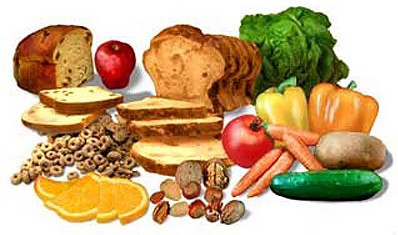FIBER UP TO LEAN DOWN
 “More energy (calories) is spent digesting and absorbing high-fiber foods. In fact, if you increase your fiber intake to 35 grams a day, you’ll automatically burn 250 calories a day, without exercising more or eating less.”
“More energy (calories) is spent digesting and absorbing high-fiber foods. In fact, if you increase your fiber intake to 35 grams a day, you’ll automatically burn 250 calories a day, without exercising more or eating less.”
Besides stabilizing blood sugar, curbing appetite, accelerating the removal of fats and cholesterol from the body and improving protein metabolism, fiber lowers heart disease risk, improves blood pressure and reduces the risk of developing certain cancers. Plus, it appears to be the perfect fat burner.
What is dietary fiber? It’s the non- or partially digestible part of plants, fruits, nuts, vegetables and grains. Although fiber is considered a complex carbohydrate, it travels through the digestive system without being changed or converted into glucose. It doesn’t contain the same number of calories found in carbohydrates, nor is it processed in the same manner. As a result you get to eat a lot of good foods without a load of fattening calories. Because of the functional differences of this unique form of carbohydrate, researchers categorize fiber in two ways: soluble and insoluble.
Soluble fiber disintegrates in water and forms a gel-like substance in the stomach. That causes swelling of the stomach contents as water is absorbed, making you feel full and slowing stomach emptying. It also causes sugar to be released from foods and absorbed at a much slower rate, reducing insulin release. Soluble fiber also binds with fats and escorts them out of the system, thus reducing or minimizing their absorption. Some sources of soluble fibers are apples, bananas, barley, beets, berries, carrots, cranberries, legumes—beans, peas, soybeans—oranges and peaches.
Insoluble fiber, commonly known as roughage, speeds up the movement of unused compounds through the intestines and increases your stool bulk. Some examples of insoluble fiber are bran, cauliflower, dried beans, flaxseed, nuts, popcorn, wheat bran, whole grain breads, cereals, oatmeal and pasta.
According to Brenda Watson, one of the country’s most notable authorities on fiber and digestive health, it is important to eat both types of fiber, although it is not necessary to count how many grams of soluble and insoluble you get daily.
It is important to make sure, however, that you’re drinking adequate amounts of water to prevent the gas and bloating associated with increased fiber intake. Watson, the author of The Fiber 35 Diet, recommends dividing your bodyweight (in pounds) by two and drinking that number of ounces of water daily. For example, if you weigh 160 pounds, you should be drinking 80 ounces per day. Also, gradually increase your fiber intake so your system can adjust to the additional fiber load. That will decrease episodes of gas and bloating.
Researchers at the Human Nutrition Unit of the Universitat Rovira i Virgili in Reus, Spain, compared the effect of different fibers on bodyfat loss, satiety, fat profile and blood sugar metabolism in a double-blind, placebo-controlled clinical trial of 200 overweight individuals. The researchers administered a mixture of three grams of plantago ovata husk fiber and one gram of glucomannan twice daily to group one—while giving group two a placebo three times daily—for 16 weeks. They reported that weight and fat loss were higher in group one after both doses of fiber vs. the placebo group.
When you increase your daily fiber intake, not only do you accelerate your body’s ability to burn fat, but the fiber also:
1) Can curb your appetite by causing the contents in your stomach to swell, making you feel full.
2) Activates the hormone cholecystokinin in the small intestine. CCK is responsible for stimulating the digestion of fats and protein, as well as acting as a messenger that tells your brain you’re full. Fiber also encourages as well as sustains the elevation of CCK in the blood.
3) Controls your blood sugar by slowing down the rate at which your body converts carbohydrate to sugar, thus discouraging the storage of fat from carbohydrates not readily used as fuel.
4) Enables you to eat more fiber-rich foods, thus reducing your calorie intake and improving elimination.
5) Can reduce insulin resistance, a key cause of obesity and the metabolic syndrome.
6) Can block the absorption of cholesterol.
7) Blocks fat absorption as fiber moves and binds with fats and escorts them through the digestive system faster so less is absorbed.
8) Minimizes catabolism, or muscle wasting, by accelerating protein metabolism.
9) Slows the absorption of calories from foods.
- Login to post comments


